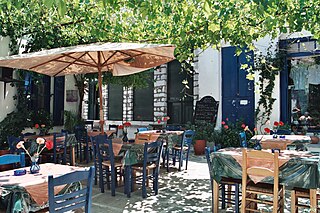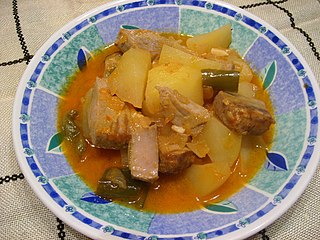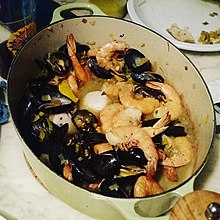
Greek cuisine is the cuisine of Greece and the Greek diaspora. In common with many other cuisines of the Mediterranean, it is founded on the triad of wheat, olive oil, and wine. It uses vegetables, olive oil, grains, fish, and meat, including pork, poultry, veal and beef, lamb, rabbit, and goat. Other important ingredients include pasta, cheese, lemon juice, herbs, olives, and yogurt. Bread made of wheat is ubiquitous; other grains, notably barley, are also used, especially for paximathia biscuits. Common dessert ingredients include nuts, honey, fruits, and filo pastries. It continues traditions from Ancient Greek and Byzantine cuisine, while incorporating Ottoman, Middle Eastern, and Italian ideas.

Chowder is a type of soup or stew often prepared with milk or cream and thickened with broken crackers, crushed ship biscuit, or a roux. Variations of chowder can be seafood or vegetable. Crackers such as oyster crackers or saltines may accompany chowders as a side item, and cracker pieces may be dropped atop the dish. New England clam chowder is typically made with chopped clams and diced potatoes, in a mixed cream and milk base, often with a small amount of butter. Other common chowders include seafood chowder, which includes fish, clams, and many other types of shellfish; lamb or veal chowder made with barley; corn chowder, which uses corn instead of clams; a wide variety of fish chowders; and potato chowder, which is often made with cheese. Fish chowder, corn chowder, lamb chowder and especially clam chowder are popular in the North American regions of New England and Atlantic Canada.

Maghreb cuisine is the cooking of the Maghreb region, the northwesternmost part of Africa along the Mediterranean Sea, consisting of the countries of Algeria, Libya, Mauritania, Morocco, and Tunisia. The region has a high degree of geographic, political, social, economic and cultural diversity which influences its cuisine and culinary style.

Christopher Richard "Rick" Stein, is an English celebrity chef, restaurateur and television presenter. Along with business partner Jill Stein he has run the Stein hotel and restaurant business in the UK for over forty years. The business has a number of renowned restaurants, shops and hotels in Padstow along with other restaurants in Marlborough, Winchester and Barnes. He is also the head chef and a co-owner of "Rick Stein at Bannisters" at Mollymook and Port Stephens in Australia, with his second wife Sarah. He has written cookery books and presented television programmes.

Bouillabaisse is a traditional Provençal fish stew originating from the port city of Marseille. The French and English form bouillabaisse comes from the Provençal Occitan word bolhabaissa, a compound that consists of the two verbs bolhir and abaissar.

Mediterranean cuisine is the foods and methods of preparation by people of the Mediterranean Basin region. The idea of a Mediterranean cuisine originates with the cookery writer Elizabeth David's book, A Book of Mediterranean Food (1950) and was amplified by other writers working in English. Many writers define the three core elements of the cuisine as the olive, wheat, and the grape, yielding olive oil, bread and pasta, and wine; other writers emphasize the diversity of the region's foods and deny that it is a useful concept. A common definition of the geographical area covered follows the distribution of the olive tree.

Lebanese cuisine is the culinary traditions and practices originating from Lebanon. It includes an abundance of whole grains, fruits, vegetables, fresh fish and seafood. Poultry is eaten more often than red meat, and when red meat is eaten, it is usually lamb and goat meat. It also includes copious amounts of garlic and olive oil, often seasoned with lemon juice. Chickpeas and parsley are also staples of the Lebanese diet.

Tuna pot, marmitako in Basque Country and marmita, marmite or sorropotún in Cantabria is a fish stew that was eaten on tuna fishing boats in the Cantabrian Sea. Today it is a simple dish with tuna, potatoes, onions, peppers, and tomatoes.

Soup is a primarily liquid food, generally served warm or hot, that is made by combining ingredients of meat or vegetables with stock, or water. Hot soups are additionally characterized by boiling solid ingredients in liquids in a pot until the flavors are extracted, forming a broth. Soups are similar to stews, and in some cases there may not be a clear distinction between the two; however, soups generally have more liquid (broth) than stews.
Fish stew is a generic name for a stew with a base or food ingredients of fish or seafood.

A stew is a combination of solid food ingredients that have been cooked in liquid and served in the resultant gravy. Ingredients in a stew can include any combination of vegetables and may include meat, especially tougher meats suitable for slow-cooking, such as beef. Poultry, sausages, and seafood are also used. While water can be used as the stew-cooking liquid, stock is also common. Seasoning and flavourings may also be added. Stews are typically cooked at a relatively low temperature, allowing flavours to mingle.

The cuisine of Cape Verde is a West African cuisine largely influenced by Portuguese, Southern and Western European and West African cuisine. Cape Verde was a colony of Portugal from its colonization until 1975.

Anchovy paste is a fish paste food product prepared using anchovies as a primary ingredient. It is used as a condiment and as an ingredient in various dishes, such as Scotch woodcock, and is a mass-produced product. It has been used for centuries to provide flavor to foods and as a source of nutrients, and it is a part of the cuisines of Great Britain, Italy, the Philippines and Vietnam. It is a major export product of Morocco.
Coconut soup is a fruit soup prepared using coconut milk or coconut fruit as a main ingredient. Many varieties of coconut soups exist in the world, including ginataan, laksa, sayur lodeh, soto, and tom kha kai, and myriad ingredients are used. They can be served hot or cold. Most coconut soups are savoury dishes, while some varieties such as binignit and kolak, are sweet dessert soups.












